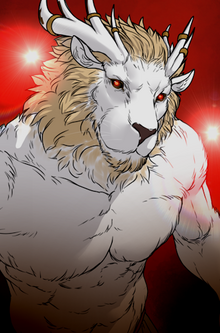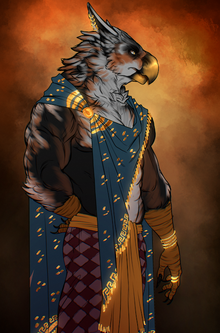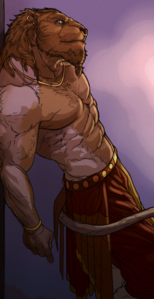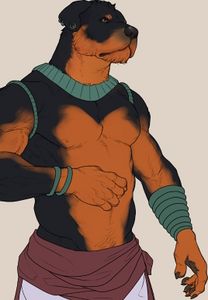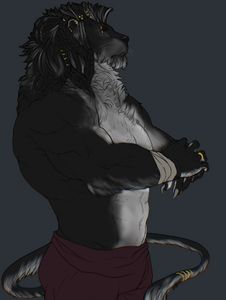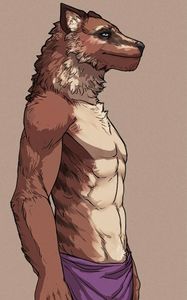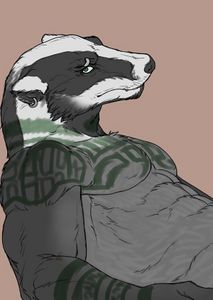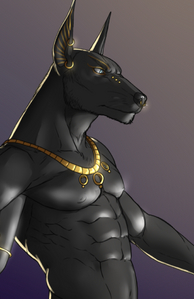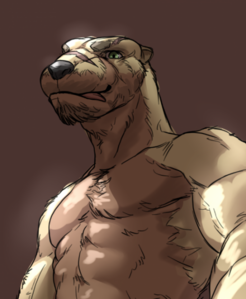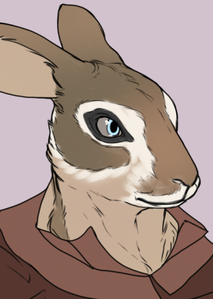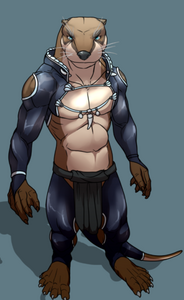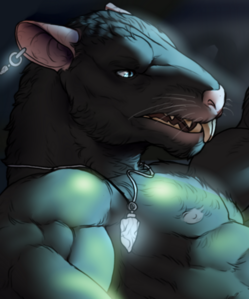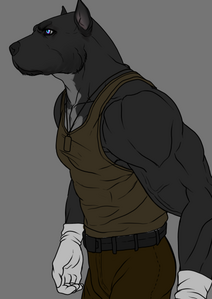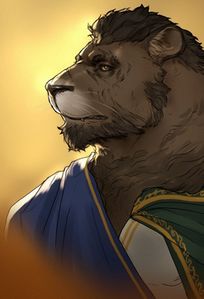More actions
No edit summary |
|||
| (103 intermediate revisions by 7 users not shown) | |||
| Line 1: | Line 1: | ||
{{Info | {{Info Lineage | ||
|image = | |name = Asha | ||
| | |test = Ankh-Sa (in Ibeth) | ||
| | |test2 = [[File:Ashaflafg.png|80px]] | ||
| | |test3 = '''Motto:''' "In Misery and Life, none left behind." | ||
| | |image = C1f01d9206ad2d5439fd5270c54b9356.png | ||
|state = The Ashal States | |||
* | |ruler = N/A | ||
* | |suzerain = N/A | ||
* | |languages = Ibeth, Common | ||
|religion = [[Baskarr]] | |||
|first_recorded = 20,000 BC | |||
|demonym = Ashal | |||
|}} | |||
The Asha are the oldest continuously existing [[Race]] on [[Aloria]], even pre-dating the Elven [[Allorn Empire]], though has undergone massive changes throughout history. Under the early [[Dewamenet Empire]], the Asha were poised to conquer vast parts of the world, however they came into conflict with the just-founded Allorn Empire. A cataclysmic war of Dewamenet Technology versus Allorn [[Magic]] erupted, which the Dewamenet lost. The surviving Dewamenet were enslaved by the Allorn Empire and used for tens of thousands of years as magically bound servants, while their Empire collapsed and their cities turned to dust. Despite [[Elven]] attempts to eradicate their culture, parts of it survived through being passed down within bound memories, and some Elves who were sympathetic to their fate. When the Allorn Empire collapsed under its own weight following the last Void Invasion, many Asha violently rose up and overthrew their Elven masters, establishing states of their own, and reconnecting with things from the past. In the modern day, the Asha are still very much affected by their millennia of servitude, with many of them having taken to the seas to attack Elven ships, try to free still enslaved Asha brethren, or turn to [[Regalia]] to discover parts of their past lost to time. The Asha are a Race that are slowly rediscovering their past in the world, and for many, to discover how the past has defined them and how they will define the future of all Asha. | |||
==Design== | |||
[[File:FAVX0VgWQAERuwn.jpg|260px|thumb|right|Asha Corsair captains are some of the most feared on the high seas.]] | |||
[[File:FBUHPrVWUAI13wb.jpg|260px|thumb|right|Asha politicians are just as capable as all other Races at dressing to impress.]] | |||
The Asha are a collective Race of anthropomorphic animal-people, the closest approximation of a "Furry-Race" on MassiveCraft. A wide range of animal types are available, from canine to equine to feline, to marsupials and more. Hybrids between species are also possible, while the Asha can have plantigrade legs and feet or digitigrade legs and clawed feet and hands. They can have a wide variety of natural eye colors, as well as natural fur colors and patterns, but there is a great deal of freedom to change, for example using leopard fur patterning for a canine-otter hybrid design. Some unnatural colors are also available to some of the Legacies. It is important to also mention the Half-Asha, who the Asha consider full members of their Race. Half-Asha are Asha born from dominant Asha parentage that show Asha traits like animal ears, tails, fur, but otherwise have more facial features of other Races. Common appearances are for example animal like eyes, ears, claws, tail and legs, but mostly [[Ailor]] or Elven skin, facial features and build. | |||
===Why Asha in Regalia=== | |||
Why Asha in Regalia is a section designed to give (new) Players some idea for why a Race might want to be in Regalia, as opposed to their homeland, as some Races are heavily homeland-coded and may need some contrivances to actually Roleplay in Regalia, where all the on-server activity takes place. While you can usually extrapolate other reasons from the Lore on this page, this section provides a few easy-access suggestions. | |||
* '''Free from Isolation:''' The Ashal States, even if they are their own, are intensely isolated from the outside world and do not allow non-Asha to their interior beyond the coastal trade cities. Many Asha are curious to the wonders of the world, and travel particularly to Regalia, where they can experience everything (including all the chaos and anarchy) that the world has to offer concentrated in one city. | |||
* '''Rediscover the Past:''' The Asha have mostly been dispossessed by other Races of their land. Over the tends of thousands of years since the fall of the Dewamenet Empire, Elves and Ailor have inhabited the lands where once their cities stood. This makes rediscovering the past contingent on the approval of these local people to engage in archeology and adventuring to discover the past, usually by obtaining permission in Regalia. | |||
* '''Reconnect with Others:''' The Asha are a very disconnected Race. Many of the Asha are still enslaved by the Elves and were not able to escape the clutches of the reborn Allorn Empire, while many are spread far and wide in the winds. Regalia acts as a neutral common ground for many Asha of different walks of life to find and connect with each other, and learn the after effects of their history on their people. | |||
* '''Center of Opportunity:''' Whatever anyone thinks of Regalia, it remains the center of opportunity to do and become literally anything. After having been deprived of opportunities for tens of thousands of years, the Asha finally stand at the cusp of becoming anything they like, and the means are usually provided in a global metropolitan place like Regalia, whether they choose to fit in or not. | |||
==Heritage Traits== | |||
When designing a Character, Proficiency Points allow for a limited Ability selection with Point Buy Packs. Heritage Traits adds free Packs and Mechanics on top of that to help with cultural themes. Free Packs grant Abilities usually, while Mechanics change the way a character functions in Roleplay through subtle, and usually out of Combat ways. In essence, Mechanics just add aesthetic flair that invest in the niche of each culture. Free Packs never raise Proficiency Points, but the character must be able to purchase them normally. (ex. if a character is a certain Affinity that locks them out of a category, they cannot take that specific free pack and must choose the alternative option.) If a Free Pack grants Magic of some type, that Magic can be of any Alignment the character can normally choose, or limited to a select alignment, which will always be written in the Free Pack description. | |||
Mixed Heritage characters (i.e. characters born from two parents of different Cultures) may take one parent's 'Free Packs' and mix and match up to 5 Mechanics from both parents, although some Peoples cannot produce Mixed Heritage children (due to Magical/Fantasy reasons). Legacies replace free-packs for mixed peoples, meaning if a mixed Asha character wants a Legacy, they must be chosen as the "Free Packs," and not take other Free Packs from their other parent. | |||
===Free Packs=== | |||
* Asha get no Free Packs by default, rather their Packs are derived from Legacy's Will (see below). | |||
===Mechanics=== | |||
* Asha can control a special liquid metal called Living Metal, that can harden and reshape on their command, and they can telekinetically move around. | |||
* Asha claws act like matches, capable of causing flint and steel sparks when struck against surfaces or each other, useful for making fire. | |||
* Asha are omnivores, but are capable of consuming raw and even spoiled meat without digestive or illness troubles. | |||
* Asha have a limited body language to do with tails, that can communicate only the following: words "like", "dislike", and "favorite". | |||
* | * Asha have perfect nightvision, capable of seeing in the dark and low light environments without needing an external light. | ||
=== | |||
Asha | |||
===Legacy's Will=== | |||
Asha have a unique mechanic called Legacy's Will, that dictates some Mechanics (and potentially Free Packs and Abilities), that can only be acquired during a particular Will Phase. There are several rules associated with Legacies, listed below. Note, there is no morally or ontologically correct Legacy, each of them represent a different way of viewing the world, the Asha themselves, but more importantly: the Elves. Legacies are also changeable, explained in the Rules below. | |||
* Each Asha Character or Asha dominant Half-Asha can choose two different Legacies, or the same Legacy Twice. | |||
* Choosing the same Legacy Twice, results in the Free Pack Bonus being doubled for that Asha. | |||
* Changing Legacies in Roleplay, results in Free Packs from lost Legacies being removed. | |||
* Asha Characters may change Legacies once per month, usually as a result of Roleplay. | |||
<table style="width: 100%;"><tr><td style="width: 25%; vertical-align: top; text-align: left;"> | |||
{| | |||
[[File:Moveonasha.png|170px|thumb|left]] | |||
| | |||
<span style="font-size:130%;><center>'''Legacy of Forgiving'''</center></span> | |||
The Legacy of Forgiving represents moving on from the past, and to focus on other things. This participarly focuses on the ideology of not holding semi-permanent animosity towards the Elves, and even allying with them. Forgiving Asha choose one [[Command_Point_Buy|Command]] Point Buy Pack for Free. | |||
|} | |||
</td><td style="vertical-align: top; width: 25%;"> | |||
{| | |||
[[File:Reconnectasha.png|170px|thumb|left]] | |||
| | |||
<span style="font-size:130%;><center>'''Legacy of Return'''</center></span> | |||
The Legacy of Return represents the desire to reconnect with the past, specifically to uncover lost knowledge of Asha Culture, Religion, and History. Legacy of Return is very pragmatic, sometimes working with enemies, all for the sake of the past. Return Asha choose one [[Tech_Point_Buy| Tech Point Buy pack]] for Free. | |||
|} | |||
</td><td style="vertical-align: top; width: 25%;"> | |||
{| | |||
[[File:Corsairasha.png|170px|thumb|left]] | |||
| | |||
<span style="font-size:130%;><center>'''Legacy of Seas'''</center></span> | |||
The Legacy of Seas represents the will to turn anger at the past towards others on the high seas, and embrace piracy. Asha who are in the Legacy of Seas, gain the Pack [[Adapt_Point_Buy#Oceanic| Ocean Adaptation]], which is a combination of tech/their natural aquatic capabilities. | |||
|} | |||
</td><td style="vertical-align: top; width: 25%;"> | |||
{| | |||
[[File:Hateasha.png|170px|thumb|left]] | |||
| | |||
<span style="font-size:130%;><center>'''Legacy of Hate'''</center></span> | |||
The Legacy of Hate represents hatred towards Elves. Hateful Asha choose one Strength or Faith (where allowed by Religion) Proficiency Category Pack for free, using these additional combat powers to attack Elves wherever it is expedient to do so to make them suffer, like the Asha have suffered. | |||
|} | |||
</center> | |||
</tr></table> | |||
<table style="width: 100%;"><tr><td style="width: 25%; vertical-align: top; text-align: left;"> | |||
{| | |||
[[File:Diplomatasha.png|170px|thumb|left]] | |||
| | |||
<span style="font-size:130%;><center>'''Legacy of Loss'''</center></span> | |||
The Legacy of Loss represents an overcoming of misery and pain at the idea of all the suffering of the present and past, and an indecision on what to do about it. Legacy of Loss is not about permanent melancholy, but about indecision. Loss Asha choose one [[Medical_Point_Buy|Medical Point Buy Pack]] or one [[Chem_Point_Buy| Chem Point Buy Pack]] for Free. | |||
|} | |||
</td><td style="vertical-align: top; width: 25%;"> | |||
{| | |||
[[File:Ashamage.png|170px|thumb|left]] | |||
| | |||
<span style="font-size:130%;><center>'''Legacy of Magic'''</center></span> | |||
The Legacy of Magic represents Asha who experiment with Magic as a source of Power, despite Magic being such a Taboo to the Asha. Magic Asha choose one [[Magic Point Buy]] Pack for free. Asha become Occult of Exist, Void, Ordial, or God Alignment in this Legacy. | |||
|} | |||
</td><td style="vertical-align: top; width: 25%;"> | |||
{| | |||
[[File:Loveasha.png|170px|thumb|left]] | |||
| | |||
<span style="font-size:130%;><center>'''Legacy of Adoration'''</center></span> | |||
The Legacy of Adoration represents Asha who believe that the past and future don't matter if nobody wants to hear what they say, seeking the adoration from the masses (or their fear), or the approval of those who pay the Asha no heed. These Asha choose one [[Roguery_Point_Buy|Roguery Point Buy Pack]] for free. | |||
|} | |||
</td><td style="vertical-align: top; width: 25%;"> | |||
{| | |||
[[File:Dragonasha.png|170px|thumb|left]] | |||
| | |||
<span style="font-size:130%;><center>'''Legacy of Dragons'''</center></span> | |||
The Legacy of Dragons represents Asha throwing their luck in with Dragons, often aligning with Archon (or being Archon). Legacy of Dragon Asha are capable of Archon, and changing Archon without outside help. Furthermore, they can also dissolve their Archon-ism themselves, a unique trait. | |||
|} | |||
</center> | |||
</tr></table> | |||
== | ===Lineages=== | ||
The Asha have so-called Lineages which act like a kind of expansion of Character Creation for the Asha. If you are just playing a standard Asha as described on this page, you can skip this section. While there is only one unified Asha Race, over the 20,000 years, some Asha have become distinct from one another through decisions made in the past by their ancestors. Lineages is an optional expansion choice to play Asha somewhat differently than normal, which may result in a different appearance, different Mechanics, and different Abilities for the Asha. Lineages cannot be taken by Mixed Heritage Characters. As this is usually a more advanced option that requires more in-depth knowledge of the Lore, we do not recommend Lineages for new Players. Lineages can be skipped/ignored without it negatively affecting Roleplay for New Players, or returning players who simply aren't interested. This Lineages section will give a very summarized overview of the mechanical effects of Lineages. If you are interested in knowing more about them, it is recommended you read the Expanded Lineages section further below on this page. | |||
<table style="width: 100%;"><tr><td style="width: 50%; vertical-align: top; text-align: left;"> | |||
<span style="font-size:150%;><center>'''Silontaar Asha'''</center></span> | |||
{| | |||
[[File:Silontussy.png|220px|caption|left]] | |||
| | |||
The Silontaar Asha are a Lineage of Asha hailing from the city-state of Silontaar on Southwynd, a continent mostly inhabited by Ailor. The Silontaar are an outlier in Asha history, after the collapse of the Dewamenet Empire causing them to be violently cut off from the homeland, the Silontaar adopted Magic to survive, and have entirely become dependent on it. Silontaar differ both mentally and physically, in that they appear more like hybrid species with magical glowing patches of fur and four times longer lifespan, and in that they tend to be more skittish and reserved than the boisterous and loud Asha, struggling with their Magical dependency and taboo in wider Asha Culture. Silontaar Asha have a different set of Heritage Traits that replace the standard Asha set. Read more on their history further below. | |||
<BR>'''Silontaar Heritage Traits''' | |||
* Silontaar Asha can Point Buy two [[Magic Point Buy]] Packs for Free. | |||
| | * Silontaar Asha can cast one Sinistral Variant Magic Spell as Radiant per day. | ||
| | * Silontaar Asha can detect the Alignment of any Ability that is used near them. | ||
* Silontaar can still use the Asha Living Metal Mechanic, but it glows instead. | |||
|} | |||
</td><td style="vertical-align: top; width: 50%;"> | |||
<span style="font-size:150%;><center>'''Sekhem Asha'''</center></span> | |||
{| | |||
[[File:Sewkhrushu.png|220px|caption|left]] | |||
| | |||
The Sekhem Asha are a Lineage of Asha hailing from the largely uninhabitable jungles that separate the Daen supercontinent and Ithania proper, no-man's land not claimed by anyone, and the perfect humid and dangerous homeland for a deranged cult of violent death worshipers. The Sekhem descended from Dewamenet soldiers caught outside the Empire during its cataclysmic collapse, and who had nothing left to go home to, their homeland gone. Many of them went insane either through the diseases and swamp fever of the jungle, or their grief in loss, creating a death-cult that has aligned with the Death God Malefica that seeks to extend their hatred to not only Elves, but to all the living. Sekhem Asha have a different set of Heritage Traits that replace the standard Asha set. Read more on their history further below. | |||
<BR>'''Sekhem Heritage Traits''' | |||
* Sekhem Asha use the [[Undead]] Affliction Traits instead of Heritage Traits. | |||
* Sekhem Asha are immune to Deathrot, but can always use Deathrot Mechanics. | |||
* Sekhem Asha despite having Undead Traits, are not actually Undead, but alive. | |||
* Sekhem can still use the Asha Living Metal Mechanic, but it is rotten rust instead. | |||
|} | |||
</center> | |||
</tr></table> | |||
| | <table style="width: 100%;"><tr><td style="width: 50%; vertical-align: top; text-align: left;"> | ||
| | <span style="font-size:150%;><center>'''Tjefet Asha'''</center></span> | ||
{| | |||
} | [[File:Sezzet.png|220px|caption|left]] | ||
| | |||
The Tjefet Asha descend from those Asha that fled the Dewamenet collapse further north, into the frozen lands of what would later become known as the Cains and Skags. The Tjefet lived a hard life there in hiding from Elven search parties until they were given more cover by the arrival of the Velheim Ailor who pushed the Elves out of the frozen wastelands. The Velheim Ailor taught their culture and beliefs to the Tjefet, who thrived in Vola-worship, tilting into the direction of Vola Fanaticism, believing that Volaheim is the true safe space for all Asha. The Tjefet are considered religious traitors to the other Asha, as they abandoned Baskarr as a dead faith, or one with weak gods. Tjefet Asha have a different set of Heritage Traits that replace the standard Asha set. Read more on their history further below. | |||
| | <BR>'''Tjefet Heritage Traits''' | ||
| | * Tjefet Asha use [[Ailor]] Heritage Traits instead of Asha Heritage Traits. | ||
* Tjefet Asha gain Mechanic 1 from Halfvel [[Godborn]]. | |||
* Tjefet Asha can be Arkenborn of Heritage-locked Arken such as Pride and Fury. | |||
* Tjefet can still use the Asha Living Metal Mechanic, but it is red steel instead. | |||
|} | |||
</td><td style="vertical-align: top; width: 50%;"> | |||
<span style="font-size:150%;><center>'''Savent Asha'''</center></span> | |||
{| | |||
[[File:Fafasdfasdfsa.png|220px|caption|left]] | |||
| | |||
The Savent Asha are a visual outlier because they are all Avian-like, as opposed to the more commonly mammalian Asha. The Savent Asha descend from a sub-group of Asha that was caught outside of the destruction of the Dewamenet Empire due to an early objection to the War against the Elves, causing an exodus of their people to a small continent north of Guldar. The Savent Asha developed a distinct and unique culture not too dissimilar from Dewamenet, but re-imagined and without the Elf-hate or Magic-hate that is so common in all other Asha. The Savent Asha still worship Baskarr along with all other Asha, but each Savent Asha has a nuanced opinion on whether the Dewamenet deserved to collapse. Savent Asha have a different set of Heritage Traits that replace the standard Asha set. Read more on their history further below. | |||
| | <BR>'''Savent Heritage Traits''' | ||
| | * Savent Asha make use of the regular Asha Heritage Traits including Legacy's Will. | ||
* Savent Asha can manifest feathered wings, which while not in combat allow (Elytra) flight (including the use of rockets). | |||
* Savent Asha can turn any metal-like substance into faux-Gold or Silver with their touch. | |||
* Savent can still use the Asha Living Metal Mechanic, but it is Gold or Silver instead. | |||
|} | |} | ||
== | </center> | ||
</tr></table> | |||
==Language & Naming== | |||
[[File:Ee0wtYEWsAAWduZ.png|260px|thumb|right|Asha acrobats and courtesans are some of the most highest sought after.]] | |||
[[File:FBjMXgzUYAY3MVh.jpg|260px|thumb|right|Living Metal is often used by Corsair Asha to replace lost limbs.]] | |||
[[File:FojDOauXgAUCAu8.jpg|260px|thumb|right|Living Metal is also used as a makeshift armor, with custom colors.]] | |||
[[File:FDOCD7ZXMAQgEP7.jpg|260px|thumb|right|Asha fur patterns do not need to be realistic, with a great deal of freedom.]] | |||
Home Asha speak a Language called Ibeth which is more of a modern take on old Dewamenet which is largely lost. Ibeth is based off real-world Ancient Egyptian, though it should be noted that language knowledge and even naming principles among the Asha are extremely varied. It is often speculated that Ibeth is only spoken by a minority, while most Sea, City, and Bound Asha speak Common, or any of the other local Ailor or Elven languages depending where they are from. The Asha distinguish an "Old Name", which is names in the style of the Dewamenet Empire (Ancient Egyptian) like Sekhet, Senefw, Nefer, Satuhotep, though it is far more common for Asha to have a name found in any other culture like Teledden, or Ailor. It is not uncommon to meet an Asha with the name James, Niall, Godric, Celen, etc, though every Asha generally has an Old Name which they mostly keep private except for close friends and other Asha. Any name works for the Asha, because they can exist next to or inside any other society. Elven naming is the only thing Asha will not criticize each other over, because it seems in bad taste to bully an Asha for having been born in slavery and having been given an Elven name. | |||
==Society== | |||
===Religion=== | |||
It is believed by most that the ancient Asha in the age of the Dewamenent worshiped a greater array of gods, or had a greater religious pluralism than may be understood now. As it stands, the current faith, the Faces of [[Baskarr]], is a narrower version of their ancient mythology, the five remaining deities kept alive by the prayers of Asha to gods they barely knew. It should be noted however that many Asha also subscribe to other religions, especially [[Unionism]] which features two native Asha Gods, allowing the Asha to find easy representation in the pantheon not easily found elsewhere. Another form of faith that is common, is [[Ordial Cultism]], usually with an emphasis on Khannar worship, but other Ordial Entities can also be found to be held among the Asha as Gods. The habit for Ordial Cultism comes from the collective societal trauma at the mistreatment of the Elves, endearing a revanchist and very fatalistic attitude in many Asha that cause them to seek higher powers from other dimensions to satisfy their desire for justice to be brought onto the knife-ears. | |||
===Fashion=== | |||
Asha clothing is often very simple in its application of garments yet rich in texture and patterning. Beyond a simple chest cloth worn by women and leather straps worn by men to attach objects to, most Asha rarely wear any clothing on their upper body when they don’t seek a reason to blend into other societies. On their lower bodies meanwhile, all wear a so-called Satoor, a dress-like clothing piece often in earthen or burgundy color tones with a variety of intricate patterns in vibrant colors that spans from the waist to the ground. These Satoors are often specially tailored to allow a tail to protrude from the back, and also have individual cuts on the front and sides to allow a free range of motion for Asha in combat. The Satoor is, in fact, a crucial piece for many cultural traditions of the Asha. As part of decoration for the Satoor, high officials may also wear shoulder capes or shoulder pelts from [[Muff-oxen]]. Jewelry is also a very much prized accessory for all genders of Asha, with numerous necklaces and ear piercings being the norm in adults. The Asha recognize the difference between a civilian Satoor and a combat Satoor in that combat Satoor cut off at the knees, while those for civilians end at the ankle or a bit higher. The Asha also have a fabric that was once unique to them alone, produced by the coastal Asha which has since expanded world-wide. [[Elastan]], a form of lycra, is made from natural blue threads excreted by the unique coral species called [[Mewnes]]. The fabric is inherently liquid deterrent, and Elastan clothing made by the Asha usually covers their arms and shoulders, as well as their legs and waist, but does not cover their torso. Elastan was eventually also mixed with other fabrics, creating [[Peltastan]], a form of wooly spandex. It has properties similar to those of Elastan, being form-fitting and soft, but Peltastan is not water repelling. Peltastan clothing is usually worn on the torso and upper leg area, while a half-Satoor is worn over it like a battle skirt, often with shoulder pads to boot. Such pads are often light and decorative, as Asha effectively do not wear armor, in order to benefit from their superior agility over other Races. When protection is required, Living Metal is capable of forming a quick, sleek coating for their defense. | |||
==Expanded Lineages== | |||
The Expanded Lineages section provides more supporting Lore for the Asha Lineages. While basic knowledge of these Asha Lineages is recommended for Asha Characters, it is not mandatory, and some of the most fun Roleplay can come from being introduced to their way of life in Character. Information is readily available for all these Lineages, even if they exist as a severe minority in the total population count of the Asha. | |||
===Silontaar Asha=== | |||
The Silontaar, unlike other Lineages, actually look physically different from most Asha, despite being Racially related. The Silontaar are never quite canine, but never quite feline either, lacking clear identifying features. Their faces are elongated like that of canines, but their nasal bridge and forehead is one continuous undented line. Their nose does not have rough skin, instead being fur covered, with only the implication of nostrils appearing as two slits between the fur layers. Their chin is sharp, with a sharp jawline also, but many Silontaar have very fluffy neck and jawline fur that obscures these sharp features and make them appear more rounded. Silontaar ears can be pointed and elongated, or rounded like that of a bear, or half round and half pointed like that of a cat. They always point backwards, unless they are in a state of alertness during which they point up. The most notable aspect about the Silontaar that absolutely sets them apart from the Asha, is that they frequently have magical glowing fur areas, and their fur patterns are very wild and have many frequently unnatural colors to them. | |||
Silontaar History begins with the collapse of the Dewamenet Empire, when the Silontaar outpost (called Silesha at the time) was cut off from the Empire. The Allorn were originally not aware of the Silesha outpost on the far continent of Oldtera, as they had at this time not yet developed cross ocean sailing ships, which the Dewamenet had. The Dewamenet were not a classical colonizing people, but had set up a mining base in Silesha, because the mountains had a rare mineral not available in what is now modern day [[Westwynd]]. When Silesha became cut off, the locals were suddenly deprived of their technological shipments, and much of their infrastructure broke down. How Magic exactly was imported into their society is unclear, though it is generally considered out of necessity, Ailor had not yet colonized the areas around Silontaar so there was nobody to trade with. | |||
The Silontaar remained extremely isolated from the rest of the world as a stagnant micro nation, largely because the mining outpost once only had a few hundred inhabitants, and because they still feared genocide by the Allorn. They reasoned that by not expanding, the Allorn would be less likely to notice them, and so they could live in peace, ignorant of the world that didn’t even know they were there. Early encounters with Ailor millennia later were far from peaceful, with Ailor being quickly seen as an invasive species that sought to deprive the Silontaar who had meanwhile established a somewhat thriving city-state in the region. The Silontaar chose not to seek out open conflict however, and instead erected a massive magical dome around their city to keep out outsiders. The Silontaar region was thus declared dead space by the Ailor colonists who created the Carrhen kingdoms around them, ignorant of the magic learning and expansion that happened exponentially under that dome. | |||
When the Silontaar came out of hiding some 3000 BC, they found the world in a pretty deplorable state. Their precursory magical scrying revealed the sad and abused state of their Asha cousins, who they thought had devolved into separate species from their once unified Dewamenet bond (though they themselves had also changed). The slow decline of the Allorn Empire was anticipated, but because the Silontaar had meanwhile developed longevity by feeding on Magic, they chose not to act and simply wait out the storm. Peaceful relations were established with their Ailor neighbors who nonetheless still kept their borders closed to the Silontaar. | |||
The | Much of Silontaar history remained exactly that: waiting for something important to happen, until the Cataclysm happened. The Silontaar were shocked by this event and motivated to finally come out of hiding, cautiously venturing into the world to try and mend the damage done to both people and the land. Silontaar adventures outside of their homeland have risen and ceased with the global acceptance of Magic, usually anchored to how Regalia viewed Magic. There was some success early on, but Silontaar once again closed their magical shield when Regalia’s Azure Order started actively hunting and killing Mages. In recent years, with the more pro-Magic policies of both Dragon Worship Regulus and Emperor Alexander I of Regalia, the Silontaar have once more come forward, trying to help people learn Magic the proper way without hurting anyone or themselves, while also undergoing magical prestige projects to try and heal the land. For example, there is currently a notable effort made in the Sundered Lands to raise all the sunken cities back to the surface. Whether the Silontaar are capable of working with other Asha depends strongly on the individual. Many Asha consider the stain of Magic the very reason why the Dewamenet Empire was destroyed, which by extension causes some blame to fall on the Silontaar for adopting the weapon of the slavers. Still, the Silontaar follow the Baskarr faith, and their goals align in general with the other Asha, they too feel grief at the loss of Dewamenet Empire, and perhaps even guilt. | ||
===Sekhem Asha=== | |||
The Sekhem Asha look identical to normal Asha, save for their obvious Ordial alignment traits, often depicted in sickly green glowing nails, teeth, horns and eyes where applicable, as well as other Ordial mutations. Sekhem Asha fled the collapse of the Allorn Empire notably into the no-man's land jungles near the Dewamenet Empire, and a combination of the pestilence of the jungle and the intense grief of loss drove those first Asha insane and into the arms of the Malefica. How or why the Malefica reached out to them is unclear, but over time, the Sekhem Asha became known as those in a state between life and un-life, a sort of Undead who are still alive, meaning all the benefits of Undead with none of the drawbacks (and they also don't physically rot). The Sekhem Asha developed an obsession with the idea of the mortuary cult, embalming, interring, but also passing any of the dead into full Undeath so as to preserve the Asha population in unlife and prevent them from becoming extinct. There was absolutely no risk of the Asha becoming extinct, as events had transpired that would ensure the continued existence of the Race, but the Malefica made the Sekhem blind to the state of the world beyond their jungles. | |||
Over the millennia, the Sekhem tended to massive underground crypts and necropolises, living among the tombs and the dead, and extending their tombs to not only include the Asha among them that did pass away or were killed in battle, but to include any living creature from the lowly insect and cattle to even Elven explorers who ventured too deep into the unknown jungles and fell into their clutches. The Sekhem Asha worship the very concept of organized Death (as opposed to violent Death), where they feel that life itself is torture and misery and only in Death can everything be preserved in a perfect and pristine state. All of the Sekhem are Malefica worshipers, or any of the other Death Cult Gods like the Consigner or the Machinist, though technology usage among the Sekhem has become nearly non-existent, as Ordial Magic and necromancy have taken over much of what Technology once did for these Asha. | |||
Contact with modern Asha has been somewhat violent and confusing for the Sekhem. While the first Sekhem who fell under the spell of the Malefica were absolutely mind broken, a capacity to reason and understand slowly returned in their descendants, so much so that they are far from insane but often calculating, observant, and decisive in their belief that the world would be better off in Undeath. When these Sekhem met the other Asha, they were appalled at the pathetic state that many ex-Slaves or Half-Asha existed in, and reviled those who still struggled with the past, as they had long settled on the way the world should work. There is no love lost between the Sekhem and the other Asha, while the Silontaar and Tjefet Asha can reasonably cooperate with Baskarr worshiping standard Asha, the Sekhem align more with the Ordial community in the Undead, Death Cultists, and the Geists. It should be no surprise, that in Regalia, the Sekhem are considered Geist or Undead even if they are technically neither, and are considered in a permanent state of illegality. | |||
===Tjefet Asha=== | |||
Tjefet Asha are not terribly complex, as much of their Culture has overlap with [[Velheim]] Ailor culture. The Tjefet Asha descend from those Asha who fled north, far into the frozen tundras and wastelands of Jorrhildr, Hvitskag, and the Cains, where they would eventually be joined by the Velheim Ailor who colonized these lands thousands of years later. The Tjefet Asha suffered much in the frozen wastelands of the north, with only the largest, meanest, and strongest of them surviving. When the Velheim Ailor brought word of the Fornoss faith, and particularly Volaheim, the Tjefet Asha (who had long believed themselves abandoned by the Baskarr Gods) ventured through the Vaarda Gates into Volaheim and were so enthralled by its paradise-like qualities that they converted to Fornoss in that moment. While the majority of Tjefet Asha are Volirik, some can also be Hvarikirk, though Vola worship is absolutely required. | |||
The Tjefet Asha became particularly fond of Rand, who they often depict as a bear-like Asha and believe to be their prophet and deliverer of misery. How it occurred is lost to time, but the whole of Tjefet Asha society became infected with Markenism at some point, meaning that through descendance, all Tjefet Asha born in the modern age are also Marken. It is believed that this was some kind of survival tactic, as this far north, not much food exists, and life is harsh for those without the strength to survive the bitter cold and the hostile wild life. On top of that, Rand actually showed particular favor towards the Tjefet Asha, teaching them the skills of Theurgy which are normally not available to Asha, or those of the Fornoss Faith. Armed with Theurgy, the Tjefet Asha went about summoning and mastering Void Spirits, bending them to their will, and hoping to achieve glory and power in the name of Rand. | |||
The re-acquaintance with other Asha from the Tjefet was met with some derision on either side. The ex-enslaved Asha thought the Tjefet had lost their minds succumbing to Demon Worship, while the Tjefet saw their Asha cousins as weak and diluted, incapable of surviving the harshness of the wider world without technology to crutch them. Eventually some kind of acceptance came into being between the two groups, though the Tjefet Asha still strongly detest the Silontaar as being exceptionally weak, even if both of them can in some instances end up using Void Magic. The Tjefet Asha are entirely uninterested in Elven reprisals, in ways, many of them are thankful for the Elves destroying the Dewamenet Empire and showing the weakness of their Baskarr Gods, so they could be delivered to the crucible of Ice and into Rand's deserving arms. Now they exist somewhere between Velheim and Asha society, attempting to achieve power and demi-godhood in the eyes of Rand and the other Vola, though often their intentions can align with other Asha on accident, for example when Hrymrök demands the extermination of Elven slavers, and the Tjefet Asha just happen to work together towards this goal with other Legacy of Hate Asha who do not follow Fornoss but Baskarr. | |||
===Savent Asha=== | |||
Savent Asha would almost be considered an entirely different people by outsiders, but they are most certainly Asha, and hybrids of species-appearances between Savent and other Asha is part of their heritage too. The Savent Asha descend from a group of peoples that objected so violently to the war between the Dewamenet Empire and the Allorn Empire on principle of non-aggression and not hating Magic, that they left the Dewamenet Empire in search for lands far away from either Empire, or Empires as a whole. The Savent at the time believed that violence was an inherent quality of Empire, and as such, people should avoid creating large geo-political powers. They settled in a largely (by Regalia) unmapped continent north of Guldar called Qelis, a temperate lake-rich land where the Savent have established 231 smaller Kingdoms and Republics that all live in perfect harmony, but are equally rather poor when compared to other countries around the world. | |||
Savent Asha are without exception, either fully Avian Asha (think Eagle, Raven, Hawk, Owl), or a hybrid between Avian Asha and mammalian Asha (for example, an eagle face with long dog ears and cat lower legs but an Avian upper body and tail). All Savent Asha have beaks, and all of them have avian forearms and claws, while some of them have wings including regal plumage. Savent Asha are otherwise physically similar to other Asha and Asha Lineages, except that they will a visual niche that is not existent in any other heritage or culture, bar from perhaps the avian ([[Maquixtl#Heritage Traits|Maquixtl Genos Form]]), who fall squarely in the terror-bird category only. | |||
The major difference besides appearance niches between Savent Asha and all other Asha, is that their psyche is in essence completely devoid of all trauma that many other Asha suffer from when looking at their history and the state of their people across the world. While there certainly is empathy and pity from the Savent in the fight against the institution of slavery, there is an equal yet soft-spoken sentiment among the Savent, that the Dewamenet got what they deserved. The Savent rejected the Dewamenet-Allorn War in all its senseless brutality (from their perspective), and deem the outcome to have "occurred in equal measure onto the Elves, to be fed to the Dewamenet Machine as fuel and un-eager hands of forced labor". Many of them in essence claim, that whatever hardships would have befallen the Asha, would have been inflicted onto the Elves if the Dewamenet had won, and that this is not a unique victimization of the Asha, but rather a sign of the more widespread depravity and hubris of Empire-politics. | |||
The | |||
That is not to say that all Savent think that the Asha "got what they deserved", there is always a very fine line to walk between being genuinely empathetic towards the suffering of the Asha, and finding the right time to discuss the causes and implications of the actions of the Asha forefathers. The Savent insist that the Dewamenet were far from innocent, and engaged in equal measure of genocide as the Elves did, it just so happened to be the case that the Elves did it better (and faster). Savent can be genuinely included in interest groups who seek to discover more of their lost historical heritage and have very real passion and emotion towards the rediscovery of lost information. There remains however, the concern from other Asha, or the thought in the back of one's mind, that a Savent is only there out of recreational reasons, and can never fully understand what it means to re-discover a culture that was so violently destroyed by the conqueror. At the end of the day, Savent can return to their own unique culture that has flourished independently from a desire to return to the old Dewamenet. | |||
Savent Culture is based on real-world Achaemenid period Persia Minor cultures (such as Lydean and Phrygean or other Anatolian Cultures of that period). However, because there is no real linguistic survival from this period, we use Achaemenid names for the people, but still use Ancient Egyptian as their language. Despite their cultural deviation, the Savent have held onto Ibeth, as well as Baskarr as a religion, even adopting the more modern interpretations as die-hard belief in their faith waned over time, and they had to ironically resort to the diluted oral survival of the captive Asha to fill the gaps. The Savent are a culture with a very strong emphasis on metallurgy, particularly working with noble metals like gold and silver, which form threads throughout their other customs and traditions. Music is for example also important to them, with several instruments being credited to their invention, and always finely decorated with in-laid gold and silver threading. | |||
Savent clothing is far simpler when compared to the Asha Satoor with its complex patterns, relying more heavily on the opulence of all that sparkles yet having very vibrant but simple patterns. The Savent tend to lean more in the direction of pacifism or at the least non-violence, vowing only to act in self-defense. That being said, Savent can be ferocious fighters, especially with their sharp beaks and talons, and several Savent arena fighters have gained fame in the Regalian Empire for their ruthless tactics in the ring. The Savent have a more cultural streak than the other Asha, enjoying the finer things in life, and attaching less value to status symbols and vanity. It should be noted, that the metals that the Savent work with (and can create with their hands) are not actual Gold and Silver, but imitation metals like Electrum, which is why having a Savent friend is not a get-rich-quick scheme. | |||
== | |||
==World View== | |||
World View is optional content that helps give Asha flavor and depth. | |||
*Asha society is one of the only societies that strictly bans Magic, even the passive usage of it primarily because Magic has played such an important role in their suffering throughout their existence. | |||
*Magic usage in the Ashal Kingdoms is strictly illegal, and on the high seas, the Asha Corsairs are known to execute Mages immediately after a battle and if any were captured. Many know this, which is why the waters around the Asha States are called the “Mageless Waters", on account of all Mages veering far around the general raiding zones of the Corsair Fleets. | |||
*Tails are immensely important to the Asha, and serve as major indicators of non-verbal emotion, and expressions of pride. An Asha without a tail is like an Asha without pride, and faces humiliation in Asha society. This is largely the reason why it was so common for the Allorn to cut off Asha tails at birth, a practice that still exists today. Some Asha have gone through lengths to re-acquire their tail, most using Living Metal to replace it. | |||
*Common uses of the tail include, but are not limited to: expressing adoration for a person depending on the tightness of a tail included in a hug, using the tail to point at desired objects or slowly caress them to show interest, swishing the tail around to express candidness or pride, binding the tail around one’s leg or waist to express fear or loathing, striking the tail on the floor for a challenge or mockery, slapping others with a tail in teasing or flirtatious manner, and holding objects of great importance with the tail by wrapping it around them. Nearly every statement or request made by Asha includes some sort of positioning or motion of their tail, indicating their intent or emotional feeling behind it. This is why it may sometimes be hard for Asha to lie to other Asha, as many of these tail movements are involuntary. | |||
*The worst insult is to pull on an Asha’s tail, stand on it, or generally just dismiss or ridicule the appendage. Asha tails are collected by some [[Kathar]] priests and priestesses for [[Void Worship]] rituals, or as trophies for the amount of Asha sacrificed to the Void Gods, largely being the reason why the Asha have a particular hatred for Kathar religious leaders, more so than all the other kinds of Kathar. | |||
*The majority of the Asha’s active military power can be found on the high seas, where they are considered some of the most skilled sailors and marines known to Aloria. Asha are unrivaled in their ability to sprint, dance, pounce, roll, and move around on deck, flinging themselves from ropes and balancing on thin beams to gain the upper hand and the higher ground. | |||
*The Asha commonly use the Shefdew, or Moon-Blade polearm in their combat with others, alongside the Sensy, a smaller blade seen used on Asha tails. These weapons both form part of the Tutelage of Mirah, the form of instruction used to teach most Corsairs and land forces of the Asha. Still, Asha are capable of picking other weapons too, and Asha mercenaries have been seen using a wide range of blades and more. | |||
*The Asha frequently use beasts of burden or large animals for the purpose of siege, or general brute force damage during a battle. These are most often the [[Maarhanet]], or [[Giant Scorpion|Seqherat]]. However, the use of Living Metal constructs has only continued to grow in recent years. | |||
*Asha cuisine is heavily varied as they are spread across Aloria. In general, they have a simple but rich diet based on meats served with spices, eggs and dairy products such as cheeses and yogurt, the dish Car-Ki’fo best exemplifying this blend of ingredients. Their meat exclusively comes from geese, quail, pigs, cows and any fish that can be caught, as they are highly sensitive to the killing of animals which look like members of their Race. | |||
*The Asha are a physical Race, meaning nearly all forms of their recreation and relaxation involve some physical activity in their society. To that end, they have developed Sun-Courts, large open-air squares for physical activity and sports to be performed in. Enormous trees or Living Metal structures serve to create some shade in these spaces, and the game of Hisad (an Asha board game) appears in such spaces on a weekly basis. | |||
*An important cultural expression of the Asha involves the Satoor is the Satoor-Bis Kahnar Hakkar, a wild dance performed by one seeking to court another. The dance itself is carried out with leaps involving fierce snarling expressions, grunting, chest beating and wild waving of claws, where the purpose is also to make the Satoor flow with poise and grace, in contrast to the intense expressions. The primary use of the dance is to impress a potential partner with an Asha's strength, though Asha can also perform it to intimidate enemies before battle. | |||
*The boundary between enemy and passion are very thin for the Asha, and the “enemy turned lover” is a frequently seen romantic trope among the Asha, impressed with enemy soldiers or warriors in battle that they fall for them. This event is a rare occurrence in Corsair warfare, as most targets of Asha attacks are slave facilities, slaving ships, and other repulsive places, with few acceptable love interests among the guardians of such places. Instead, it often takes root in fighting pits, or tournament bouts. | |||
*The ritual marriages between the Queens of the Ashal Kingdoms and the various Corsair leaders are part of the agreements of assistance between these Kingdoms and their ever-sharpening sword in world affairs. The rituals sometimes become actual marriages, but such connections strain the relationship as the Queens insist on keeping all daughters, and reject sons, while the Corsairs consider the intense focus on women from the city-dwellers to be a detriment. | |||
*The Ashal Islands have two notable forms of coastal port. One is the Fair-Port, called Hesepah by the Asha, and is the sole area of the Islands where foreign Races can be found in great abundance. Merchants and artisans live and thrive in this place, and the limited trade the Kingdoms have with the wider world comes through this center. The other form of port are the Moon-Ports, massive facilities capable of handling the hundreds of ships that Corsair Fleets possess. Each Ashal Kingdom has one of these for the use by the Fleets, who cycle in and out of docking their ships for resupply, repair, and celebrations. | |||
*The Great Journey is revered by the Asha as their period of migration from the lands of the former Allorn Empire to their new home in the Ashal Isles. The entire process took three years, and was led by the Siwath-Khenu who emerged to guide their people home. The event is also notable for the baggage train of Ailor and other Races, fellow former slaves, who followed or shadowed the Journey, despite being told they could not settle with the Asha. These other groups ultimately settled along the coastline, and became nations like [[List_of_Major_Nations_and_States#Daen_Governate|Daen]] and [[Lusits]]. | |||
*The Siwath-Khenu are currently believed to be focusing on those Asha still mass-enslaved in Ithania, and while overseers, masters and more are keeping their eyes peeled, whispers speak of their mission preparing their fellow Asha for freedom is well underway. | |||
*Unlike the Silontaar, who have a manic fear of the [[Maraya]], the Asha find the Maraya kindred spirits in most cases. Both Races suffered extreme loss in the past, and only recently recovered, or in the Maraya’s case, reawoke, to seek out their long damaged heritage. They also both have unique technologies crafted and specific to their Race. The Asha chalk the Silontaar’s manic paranoia to a corruption of Magic in their very blood, affecting how they see the world, and other dismissive, negative statements. | |||
*The loss of the Repyt Corsair Fleet, which merged with Fin’ullen elements to form the Asha-Fin’ullen [[Fin’ullen#Culture|Sàllir]] subculture, was deeply shocking to the Asha Race as a whole. The Arc-Monoliths are frequently harassed by Corsair Fleets and Fin’ullen ships alike, both core elements of each Race disturbed by this union of Asha and Nelfin elements together. The Asha have not attacked their brethren outright, however, for unclear reasons, and any Corsair Fleet element that has done so has been disowned by Fleet leadership. | |||
*The recent rebirth of the Allorn Empire was an extreme blow to Asha hopes for the future, as the fractured politics of the Teledden and Fin’ullen until that point made Corsair raiding operations far easier. Most Corsair Fleets have been forced to pull back from attacks on the Allorn as a result, and have turned their focus on Westwynd and other more central or southern locations. | |||
== | ==Gallery of Art== | ||
Asha | Asha are really cool and awesome, and lots of art has been made of them. | ||
<gallery mode="traditional" widths="260px" heights="300px"> | |||
File:Senef.png|The Satoor is technically a dress, but appears more like stylish fabric with a lean fit. | |||
File:FBO5Tz6XMAIvMmu.jpg| Asha prefer to go shirtless, though can also wear Ailor clothes in case they want to fit in. | |||
File:FcpYmX0X0AARwyy.jpg| Asha can get really really big, if they put in the work. | |||
File:D-sF2wtXYAAHUDM.jpg| Not all Asha have to be muscular tanks, unlike what this Wiki page may imply. | |||
File:EQTj6IuWkAE7oz4.jpg| Fur painting to appear like tattoos are fairly common among the lower social class Asha. | |||
File:EnKxRY7XIAElnhq.png| Dewet Fashion means using ancient egyptian aesthetics to appeal to the old Dewamenet legacy. | |||
File:493px-Downotter.png| Otter Asha are known to be energetic and fun loving Asha, even as Bound Asha. | |||
File:Rabbo2.png| Rodent Asha are less common, but nonetheless still good friends to have. | |||
File:Elastaanpopular.png| Elastaan is very popular as a fabric not only among the Asha, but also Regalians. | |||
File:499px-28b92e4a58189b5bd2dc107958d9674a.png| Rat Asha are fierce fighters, with many of them working as gladiators in Regalia. | |||
File:59fad4ed89eb7540eb0ba32c0d16ab17.png| Equally, other types of Asha are commonly found due to their ferocious fighting skills. | |||
File:Eu9xO7BXcAIqqWG.jpg| Even if the Asha look like predators, some still have a very calm and kind expression. | |||
</gallery> | |||
==Trivia== | ==Trivia== | ||
* | *There has been recent evidence that suggests the Asha may be far older than previously thought. Records of the fall of the [[Meraic Empire]], released in 310 AC, show mammalian humanoids in service to the Race that would become the Maraya, and there is also the extreme paranoia the Silontaar have for that pastel Race. | ||
*There are a total of sixteen Corsair Fleets in operation across Aloria, but five are most notable among their number. These include the Medes Fleet led by the unique dual leadership of Ladies Saalamun and Vasnaf, the Sefetjew Fleet led by Lord Kahnef or “Lord Demon-claw” and the Kheni-Hetef Fleet led by Lord [[Ammunakhonet]], an [[Undead]] warrior who has led his fleet since it was created nearly three centuries ago. | |||
* | *Some believe there are members of the Faces of Baskarr who were long ago killed by the gods of the [[Estelley]] pantheon in the war between the Allorn and Dewamenent Empires. It is commonly said only the sages of the Siwath-Khenu could answer such questions, and they are very difficult to locate. | ||
{{ | {{Peoples}} | ||
{{Accreditation | {{Accreditation | ||
|Artists = MonMarty | |Artists = MonMarty | ||
|Writers = MonMarty | |Writers = MonMarty | ||
|Processors = | |Processors = WaterDruppel, FireFan96 | ||
}} | }} | ||
[[category:races]] [[category:Gorr Races]] | [[category:races]] [[category:Gorr Races]] | ||
Revision as of 21:35, 5 May 2024
| Asha | |
|---|---|
 | |
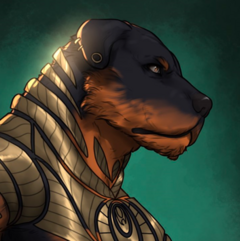 | |
| Nation State | The Ashal States |
| Ruler | N/A |
| Other Present | N/A |
| Languages | Ibeth, Common |
| Religion | Baskarr |
| First Recorded | 20,000 BC |
| Demonym(s) | Ashal |
The Asha are the oldest continuously existing Race on Aloria, even pre-dating the Elven Allorn Empire, though has undergone massive changes throughout history. Under the early Dewamenet Empire, the Asha were poised to conquer vast parts of the world, however they came into conflict with the just-founded Allorn Empire. A cataclysmic war of Dewamenet Technology versus Allorn Magic erupted, which the Dewamenet lost. The surviving Dewamenet were enslaved by the Allorn Empire and used for tens of thousands of years as magically bound servants, while their Empire collapsed and their cities turned to dust. Despite Elven attempts to eradicate their culture, parts of it survived through being passed down within bound memories, and some Elves who were sympathetic to their fate. When the Allorn Empire collapsed under its own weight following the last Void Invasion, many Asha violently rose up and overthrew their Elven masters, establishing states of their own, and reconnecting with things from the past. In the modern day, the Asha are still very much affected by their millennia of servitude, with many of them having taken to the seas to attack Elven ships, try to free still enslaved Asha brethren, or turn to Regalia to discover parts of their past lost to time. The Asha are a Race that are slowly rediscovering their past in the world, and for many, to discover how the past has defined them and how they will define the future of all Asha.
Design
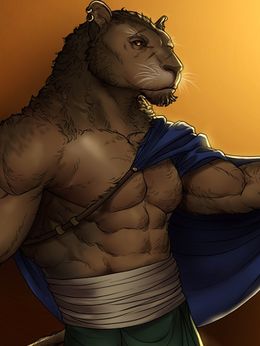
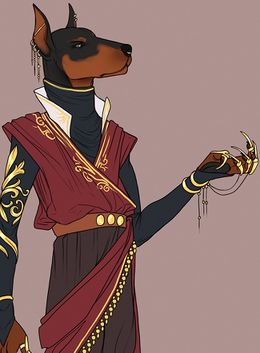
The Asha are a collective Race of anthropomorphic animal-people, the closest approximation of a "Furry-Race" on MassiveCraft. A wide range of animal types are available, from canine to equine to feline, to marsupials and more. Hybrids between species are also possible, while the Asha can have plantigrade legs and feet or digitigrade legs and clawed feet and hands. They can have a wide variety of natural eye colors, as well as natural fur colors and patterns, but there is a great deal of freedom to change, for example using leopard fur patterning for a canine-otter hybrid design. Some unnatural colors are also available to some of the Legacies. It is important to also mention the Half-Asha, who the Asha consider full members of their Race. Half-Asha are Asha born from dominant Asha parentage that show Asha traits like animal ears, tails, fur, but otherwise have more facial features of other Races. Common appearances are for example animal like eyes, ears, claws, tail and legs, but mostly Ailor or Elven skin, facial features and build.
Why Asha in Regalia
Why Asha in Regalia is a section designed to give (new) Players some idea for why a Race might want to be in Regalia, as opposed to their homeland, as some Races are heavily homeland-coded and may need some contrivances to actually Roleplay in Regalia, where all the on-server activity takes place. While you can usually extrapolate other reasons from the Lore on this page, this section provides a few easy-access suggestions.
- Free from Isolation: The Ashal States, even if they are their own, are intensely isolated from the outside world and do not allow non-Asha to their interior beyond the coastal trade cities. Many Asha are curious to the wonders of the world, and travel particularly to Regalia, where they can experience everything (including all the chaos and anarchy) that the world has to offer concentrated in one city.
- Rediscover the Past: The Asha have mostly been dispossessed by other Races of their land. Over the tends of thousands of years since the fall of the Dewamenet Empire, Elves and Ailor have inhabited the lands where once their cities stood. This makes rediscovering the past contingent on the approval of these local people to engage in archeology and adventuring to discover the past, usually by obtaining permission in Regalia.
- Reconnect with Others: The Asha are a very disconnected Race. Many of the Asha are still enslaved by the Elves and were not able to escape the clutches of the reborn Allorn Empire, while many are spread far and wide in the winds. Regalia acts as a neutral common ground for many Asha of different walks of life to find and connect with each other, and learn the after effects of their history on their people.
- Center of Opportunity: Whatever anyone thinks of Regalia, it remains the center of opportunity to do and become literally anything. After having been deprived of opportunities for tens of thousands of years, the Asha finally stand at the cusp of becoming anything they like, and the means are usually provided in a global metropolitan place like Regalia, whether they choose to fit in or not.
Heritage Traits
When designing a Character, Proficiency Points allow for a limited Ability selection with Point Buy Packs. Heritage Traits adds free Packs and Mechanics on top of that to help with cultural themes. Free Packs grant Abilities usually, while Mechanics change the way a character functions in Roleplay through subtle, and usually out of Combat ways. In essence, Mechanics just add aesthetic flair that invest in the niche of each culture. Free Packs never raise Proficiency Points, but the character must be able to purchase them normally. (ex. if a character is a certain Affinity that locks them out of a category, they cannot take that specific free pack and must choose the alternative option.) If a Free Pack grants Magic of some type, that Magic can be of any Alignment the character can normally choose, or limited to a select alignment, which will always be written in the Free Pack description.
Mixed Heritage characters (i.e. characters born from two parents of different Cultures) may take one parent's 'Free Packs' and mix and match up to 5 Mechanics from both parents, although some Peoples cannot produce Mixed Heritage children (due to Magical/Fantasy reasons). Legacies replace free-packs for mixed peoples, meaning if a mixed Asha character wants a Legacy, they must be chosen as the "Free Packs," and not take other Free Packs from their other parent.
Free Packs
- Asha get no Free Packs by default, rather their Packs are derived from Legacy's Will (see below).
Mechanics
- Asha can control a special liquid metal called Living Metal, that can harden and reshape on their command, and they can telekinetically move around.
- Asha claws act like matches, capable of causing flint and steel sparks when struck against surfaces or each other, useful for making fire.
- Asha are omnivores, but are capable of consuming raw and even spoiled meat without digestive or illness troubles.
- Asha have a limited body language to do with tails, that can communicate only the following: words "like", "dislike", and "favorite".
- Asha have perfect nightvision, capable of seeing in the dark and low light environments without needing an external light.
Legacy's Will
Asha have a unique mechanic called Legacy's Will, that dictates some Mechanics (and potentially Free Packs and Abilities), that can only be acquired during a particular Will Phase. There are several rules associated with Legacies, listed below. Note, there is no morally or ontologically correct Legacy, each of them represent a different way of viewing the world, the Asha themselves, but more importantly: the Elves. Legacies are also changeable, explained in the Rules below.
- Each Asha Character or Asha dominant Half-Asha can choose two different Legacies, or the same Legacy Twice.
- Choosing the same Legacy Twice, results in the Free Pack Bonus being doubled for that Asha.
- Changing Legacies in Roleplay, results in Free Packs from lost Legacies being removed.
- Asha Characters may change Legacies once per month, usually as a result of Roleplay.
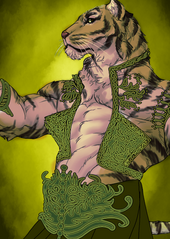
|
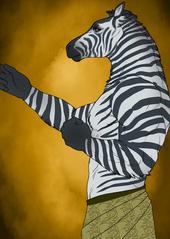
|
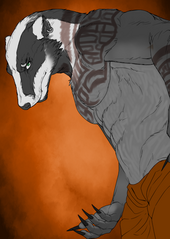
|
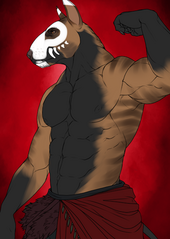
|
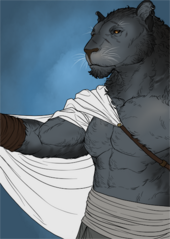
|
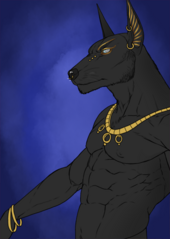
|
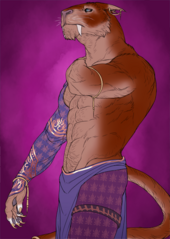
|
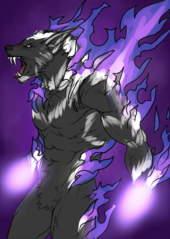
|
Lineages
The Asha have so-called Lineages which act like a kind of expansion of Character Creation for the Asha. If you are just playing a standard Asha as described on this page, you can skip this section. While there is only one unified Asha Race, over the 20,000 years, some Asha have become distinct from one another through decisions made in the past by their ancestors. Lineages is an optional expansion choice to play Asha somewhat differently than normal, which may result in a different appearance, different Mechanics, and different Abilities for the Asha. Lineages cannot be taken by Mixed Heritage Characters. As this is usually a more advanced option that requires more in-depth knowledge of the Lore, we do not recommend Lineages for new Players. Lineages can be skipped/ignored without it negatively affecting Roleplay for New Players, or returning players who simply aren't interested. This Lineages section will give a very summarized overview of the mechanical effects of Lineages. If you are interested in knowing more about them, it is recommended you read the Expanded Lineages section further below on this page.
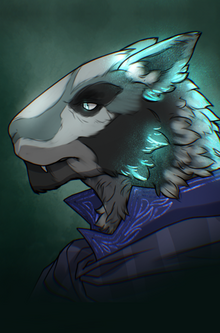
|
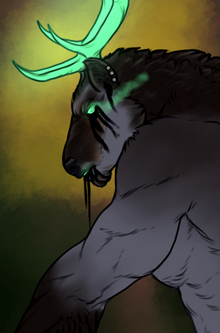
|
Language & Naming
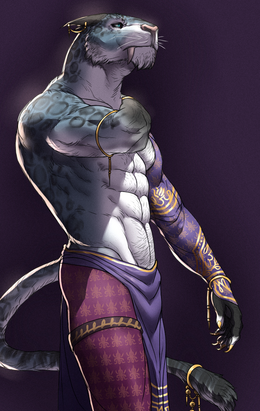
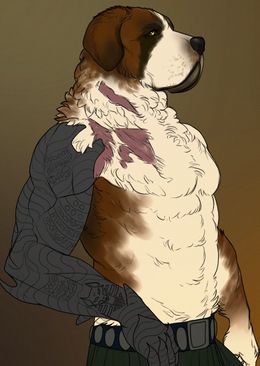
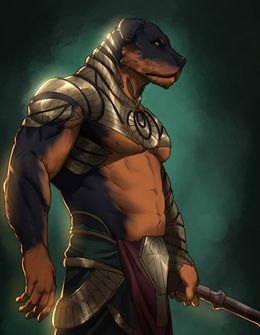
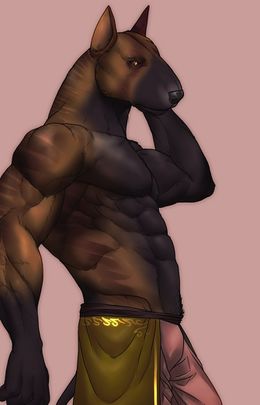
Home Asha speak a Language called Ibeth which is more of a modern take on old Dewamenet which is largely lost. Ibeth is based off real-world Ancient Egyptian, though it should be noted that language knowledge and even naming principles among the Asha are extremely varied. It is often speculated that Ibeth is only spoken by a minority, while most Sea, City, and Bound Asha speak Common, or any of the other local Ailor or Elven languages depending where they are from. The Asha distinguish an "Old Name", which is names in the style of the Dewamenet Empire (Ancient Egyptian) like Sekhet, Senefw, Nefer, Satuhotep, though it is far more common for Asha to have a name found in any other culture like Teledden, or Ailor. It is not uncommon to meet an Asha with the name James, Niall, Godric, Celen, etc, though every Asha generally has an Old Name which they mostly keep private except for close friends and other Asha. Any name works for the Asha, because they can exist next to or inside any other society. Elven naming is the only thing Asha will not criticize each other over, because it seems in bad taste to bully an Asha for having been born in slavery and having been given an Elven name.
Society
Religion
It is believed by most that the ancient Asha in the age of the Dewamenent worshiped a greater array of gods, or had a greater religious pluralism than may be understood now. As it stands, the current faith, the Faces of Baskarr, is a narrower version of their ancient mythology, the five remaining deities kept alive by the prayers of Asha to gods they barely knew. It should be noted however that many Asha also subscribe to other religions, especially Unionism which features two native Asha Gods, allowing the Asha to find easy representation in the pantheon not easily found elsewhere. Another form of faith that is common, is Ordial Cultism, usually with an emphasis on Khannar worship, but other Ordial Entities can also be found to be held among the Asha as Gods. The habit for Ordial Cultism comes from the collective societal trauma at the mistreatment of the Elves, endearing a revanchist and very fatalistic attitude in many Asha that cause them to seek higher powers from other dimensions to satisfy their desire for justice to be brought onto the knife-ears.
Fashion
Asha clothing is often very simple in its application of garments yet rich in texture and patterning. Beyond a simple chest cloth worn by women and leather straps worn by men to attach objects to, most Asha rarely wear any clothing on their upper body when they don’t seek a reason to blend into other societies. On their lower bodies meanwhile, all wear a so-called Satoor, a dress-like clothing piece often in earthen or burgundy color tones with a variety of intricate patterns in vibrant colors that spans from the waist to the ground. These Satoors are often specially tailored to allow a tail to protrude from the back, and also have individual cuts on the front and sides to allow a free range of motion for Asha in combat. The Satoor is, in fact, a crucial piece for many cultural traditions of the Asha. As part of decoration for the Satoor, high officials may also wear shoulder capes or shoulder pelts from Muff-oxen. Jewelry is also a very much prized accessory for all genders of Asha, with numerous necklaces and ear piercings being the norm in adults. The Asha recognize the difference between a civilian Satoor and a combat Satoor in that combat Satoor cut off at the knees, while those for civilians end at the ankle or a bit higher. The Asha also have a fabric that was once unique to them alone, produced by the coastal Asha which has since expanded world-wide. Elastan, a form of lycra, is made from natural blue threads excreted by the unique coral species called Mewnes. The fabric is inherently liquid deterrent, and Elastan clothing made by the Asha usually covers their arms and shoulders, as well as their legs and waist, but does not cover their torso. Elastan was eventually also mixed with other fabrics, creating Peltastan, a form of wooly spandex. It has properties similar to those of Elastan, being form-fitting and soft, but Peltastan is not water repelling. Peltastan clothing is usually worn on the torso and upper leg area, while a half-Satoor is worn over it like a battle skirt, often with shoulder pads to boot. Such pads are often light and decorative, as Asha effectively do not wear armor, in order to benefit from their superior agility over other Races. When protection is required, Living Metal is capable of forming a quick, sleek coating for their defense.
Expanded Lineages
The Expanded Lineages section provides more supporting Lore for the Asha Lineages. While basic knowledge of these Asha Lineages is recommended for Asha Characters, it is not mandatory, and some of the most fun Roleplay can come from being introduced to their way of life in Character. Information is readily available for all these Lineages, even if they exist as a severe minority in the total population count of the Asha.
Silontaar Asha
The Silontaar, unlike other Lineages, actually look physically different from most Asha, despite being Racially related. The Silontaar are never quite canine, but never quite feline either, lacking clear identifying features. Their faces are elongated like that of canines, but their nasal bridge and forehead is one continuous undented line. Their nose does not have rough skin, instead being fur covered, with only the implication of nostrils appearing as two slits between the fur layers. Their chin is sharp, with a sharp jawline also, but many Silontaar have very fluffy neck and jawline fur that obscures these sharp features and make them appear more rounded. Silontaar ears can be pointed and elongated, or rounded like that of a bear, or half round and half pointed like that of a cat. They always point backwards, unless they are in a state of alertness during which they point up. The most notable aspect about the Silontaar that absolutely sets them apart from the Asha, is that they frequently have magical glowing fur areas, and their fur patterns are very wild and have many frequently unnatural colors to them.
Silontaar History begins with the collapse of the Dewamenet Empire, when the Silontaar outpost (called Silesha at the time) was cut off from the Empire. The Allorn were originally not aware of the Silesha outpost on the far continent of Oldtera, as they had at this time not yet developed cross ocean sailing ships, which the Dewamenet had. The Dewamenet were not a classical colonizing people, but had set up a mining base in Silesha, because the mountains had a rare mineral not available in what is now modern day Westwynd. When Silesha became cut off, the locals were suddenly deprived of their technological shipments, and much of their infrastructure broke down. How Magic exactly was imported into their society is unclear, though it is generally considered out of necessity, Ailor had not yet colonized the areas around Silontaar so there was nobody to trade with.
The Silontaar remained extremely isolated from the rest of the world as a stagnant micro nation, largely because the mining outpost once only had a few hundred inhabitants, and because they still feared genocide by the Allorn. They reasoned that by not expanding, the Allorn would be less likely to notice them, and so they could live in peace, ignorant of the world that didn’t even know they were there. Early encounters with Ailor millennia later were far from peaceful, with Ailor being quickly seen as an invasive species that sought to deprive the Silontaar who had meanwhile established a somewhat thriving city-state in the region. The Silontaar chose not to seek out open conflict however, and instead erected a massive magical dome around their city to keep out outsiders. The Silontaar region was thus declared dead space by the Ailor colonists who created the Carrhen kingdoms around them, ignorant of the magic learning and expansion that happened exponentially under that dome.
When the Silontaar came out of hiding some 3000 BC, they found the world in a pretty deplorable state. Their precursory magical scrying revealed the sad and abused state of their Asha cousins, who they thought had devolved into separate species from their once unified Dewamenet bond (though they themselves had also changed). The slow decline of the Allorn Empire was anticipated, but because the Silontaar had meanwhile developed longevity by feeding on Magic, they chose not to act and simply wait out the storm. Peaceful relations were established with their Ailor neighbors who nonetheless still kept their borders closed to the Silontaar.
Much of Silontaar history remained exactly that: waiting for something important to happen, until the Cataclysm happened. The Silontaar were shocked by this event and motivated to finally come out of hiding, cautiously venturing into the world to try and mend the damage done to both people and the land. Silontaar adventures outside of their homeland have risen and ceased with the global acceptance of Magic, usually anchored to how Regalia viewed Magic. There was some success early on, but Silontaar once again closed their magical shield when Regalia’s Azure Order started actively hunting and killing Mages. In recent years, with the more pro-Magic policies of both Dragon Worship Regulus and Emperor Alexander I of Regalia, the Silontaar have once more come forward, trying to help people learn Magic the proper way without hurting anyone or themselves, while also undergoing magical prestige projects to try and heal the land. For example, there is currently a notable effort made in the Sundered Lands to raise all the sunken cities back to the surface. Whether the Silontaar are capable of working with other Asha depends strongly on the individual. Many Asha consider the stain of Magic the very reason why the Dewamenet Empire was destroyed, which by extension causes some blame to fall on the Silontaar for adopting the weapon of the slavers. Still, the Silontaar follow the Baskarr faith, and their goals align in general with the other Asha, they too feel grief at the loss of Dewamenet Empire, and perhaps even guilt.
Sekhem Asha
The Sekhem Asha look identical to normal Asha, save for their obvious Ordial alignment traits, often depicted in sickly green glowing nails, teeth, horns and eyes where applicable, as well as other Ordial mutations. Sekhem Asha fled the collapse of the Allorn Empire notably into the no-man's land jungles near the Dewamenet Empire, and a combination of the pestilence of the jungle and the intense grief of loss drove those first Asha insane and into the arms of the Malefica. How or why the Malefica reached out to them is unclear, but over time, the Sekhem Asha became known as those in a state between life and un-life, a sort of Undead who are still alive, meaning all the benefits of Undead with none of the drawbacks (and they also don't physically rot). The Sekhem Asha developed an obsession with the idea of the mortuary cult, embalming, interring, but also passing any of the dead into full Undeath so as to preserve the Asha population in unlife and prevent them from becoming extinct. There was absolutely no risk of the Asha becoming extinct, as events had transpired that would ensure the continued existence of the Race, but the Malefica made the Sekhem blind to the state of the world beyond their jungles.
Over the millennia, the Sekhem tended to massive underground crypts and necropolises, living among the tombs and the dead, and extending their tombs to not only include the Asha among them that did pass away or were killed in battle, but to include any living creature from the lowly insect and cattle to even Elven explorers who ventured too deep into the unknown jungles and fell into their clutches. The Sekhem Asha worship the very concept of organized Death (as opposed to violent Death), where they feel that life itself is torture and misery and only in Death can everything be preserved in a perfect and pristine state. All of the Sekhem are Malefica worshipers, or any of the other Death Cult Gods like the Consigner or the Machinist, though technology usage among the Sekhem has become nearly non-existent, as Ordial Magic and necromancy have taken over much of what Technology once did for these Asha.
Contact with modern Asha has been somewhat violent and confusing for the Sekhem. While the first Sekhem who fell under the spell of the Malefica were absolutely mind broken, a capacity to reason and understand slowly returned in their descendants, so much so that they are far from insane but often calculating, observant, and decisive in their belief that the world would be better off in Undeath. When these Sekhem met the other Asha, they were appalled at the pathetic state that many ex-Slaves or Half-Asha existed in, and reviled those who still struggled with the past, as they had long settled on the way the world should work. There is no love lost between the Sekhem and the other Asha, while the Silontaar and Tjefet Asha can reasonably cooperate with Baskarr worshiping standard Asha, the Sekhem align more with the Ordial community in the Undead, Death Cultists, and the Geists. It should be no surprise, that in Regalia, the Sekhem are considered Geist or Undead even if they are technically neither, and are considered in a permanent state of illegality.
Tjefet Asha
Tjefet Asha are not terribly complex, as much of their Culture has overlap with Velheim Ailor culture. The Tjefet Asha descend from those Asha who fled north, far into the frozen tundras and wastelands of Jorrhildr, Hvitskag, and the Cains, where they would eventually be joined by the Velheim Ailor who colonized these lands thousands of years later. The Tjefet Asha suffered much in the frozen wastelands of the north, with only the largest, meanest, and strongest of them surviving. When the Velheim Ailor brought word of the Fornoss faith, and particularly Volaheim, the Tjefet Asha (who had long believed themselves abandoned by the Baskarr Gods) ventured through the Vaarda Gates into Volaheim and were so enthralled by its paradise-like qualities that they converted to Fornoss in that moment. While the majority of Tjefet Asha are Volirik, some can also be Hvarikirk, though Vola worship is absolutely required.
The Tjefet Asha became particularly fond of Rand, who they often depict as a bear-like Asha and believe to be their prophet and deliverer of misery. How it occurred is lost to time, but the whole of Tjefet Asha society became infected with Markenism at some point, meaning that through descendance, all Tjefet Asha born in the modern age are also Marken. It is believed that this was some kind of survival tactic, as this far north, not much food exists, and life is harsh for those without the strength to survive the bitter cold and the hostile wild life. On top of that, Rand actually showed particular favor towards the Tjefet Asha, teaching them the skills of Theurgy which are normally not available to Asha, or those of the Fornoss Faith. Armed with Theurgy, the Tjefet Asha went about summoning and mastering Void Spirits, bending them to their will, and hoping to achieve glory and power in the name of Rand.
The re-acquaintance with other Asha from the Tjefet was met with some derision on either side. The ex-enslaved Asha thought the Tjefet had lost their minds succumbing to Demon Worship, while the Tjefet saw their Asha cousins as weak and diluted, incapable of surviving the harshness of the wider world without technology to crutch them. Eventually some kind of acceptance came into being between the two groups, though the Tjefet Asha still strongly detest the Silontaar as being exceptionally weak, even if both of them can in some instances end up using Void Magic. The Tjefet Asha are entirely uninterested in Elven reprisals, in ways, many of them are thankful for the Elves destroying the Dewamenet Empire and showing the weakness of their Baskarr Gods, so they could be delivered to the crucible of Ice and into Rand's deserving arms. Now they exist somewhere between Velheim and Asha society, attempting to achieve power and demi-godhood in the eyes of Rand and the other Vola, though often their intentions can align with other Asha on accident, for example when Hrymrök demands the extermination of Elven slavers, and the Tjefet Asha just happen to work together towards this goal with other Legacy of Hate Asha who do not follow Fornoss but Baskarr.
Savent Asha
Savent Asha would almost be considered an entirely different people by outsiders, but they are most certainly Asha, and hybrids of species-appearances between Savent and other Asha is part of their heritage too. The Savent Asha descend from a group of peoples that objected so violently to the war between the Dewamenet Empire and the Allorn Empire on principle of non-aggression and not hating Magic, that they left the Dewamenet Empire in search for lands far away from either Empire, or Empires as a whole. The Savent at the time believed that violence was an inherent quality of Empire, and as such, people should avoid creating large geo-political powers. They settled in a largely (by Regalia) unmapped continent north of Guldar called Qelis, a temperate lake-rich land where the Savent have established 231 smaller Kingdoms and Republics that all live in perfect harmony, but are equally rather poor when compared to other countries around the world.
Savent Asha are without exception, either fully Avian Asha (think Eagle, Raven, Hawk, Owl), or a hybrid between Avian Asha and mammalian Asha (for example, an eagle face with long dog ears and cat lower legs but an Avian upper body and tail). All Savent Asha have beaks, and all of them have avian forearms and claws, while some of them have wings including regal plumage. Savent Asha are otherwise physically similar to other Asha and Asha Lineages, except that they will a visual niche that is not existent in any other heritage or culture, bar from perhaps the avian (Maquixtl Genos Form), who fall squarely in the terror-bird category only.
The major difference besides appearance niches between Savent Asha and all other Asha, is that their psyche is in essence completely devoid of all trauma that many other Asha suffer from when looking at their history and the state of their people across the world. While there certainly is empathy and pity from the Savent in the fight against the institution of slavery, there is an equal yet soft-spoken sentiment among the Savent, that the Dewamenet got what they deserved. The Savent rejected the Dewamenet-Allorn War in all its senseless brutality (from their perspective), and deem the outcome to have "occurred in equal measure onto the Elves, to be fed to the Dewamenet Machine as fuel and un-eager hands of forced labor". Many of them in essence claim, that whatever hardships would have befallen the Asha, would have been inflicted onto the Elves if the Dewamenet had won, and that this is not a unique victimization of the Asha, but rather a sign of the more widespread depravity and hubris of Empire-politics.
That is not to say that all Savent think that the Asha "got what they deserved", there is always a very fine line to walk between being genuinely empathetic towards the suffering of the Asha, and finding the right time to discuss the causes and implications of the actions of the Asha forefathers. The Savent insist that the Dewamenet were far from innocent, and engaged in equal measure of genocide as the Elves did, it just so happened to be the case that the Elves did it better (and faster). Savent can be genuinely included in interest groups who seek to discover more of their lost historical heritage and have very real passion and emotion towards the rediscovery of lost information. There remains however, the concern from other Asha, or the thought in the back of one's mind, that a Savent is only there out of recreational reasons, and can never fully understand what it means to re-discover a culture that was so violently destroyed by the conqueror. At the end of the day, Savent can return to their own unique culture that has flourished independently from a desire to return to the old Dewamenet.
Savent Culture is based on real-world Achaemenid period Persia Minor cultures (such as Lydean and Phrygean or other Anatolian Cultures of that period). However, because there is no real linguistic survival from this period, we use Achaemenid names for the people, but still use Ancient Egyptian as their language. Despite their cultural deviation, the Savent have held onto Ibeth, as well as Baskarr as a religion, even adopting the more modern interpretations as die-hard belief in their faith waned over time, and they had to ironically resort to the diluted oral survival of the captive Asha to fill the gaps. The Savent are a culture with a very strong emphasis on metallurgy, particularly working with noble metals like gold and silver, which form threads throughout their other customs and traditions. Music is for example also important to them, with several instruments being credited to their invention, and always finely decorated with in-laid gold and silver threading.
Savent clothing is far simpler when compared to the Asha Satoor with its complex patterns, relying more heavily on the opulence of all that sparkles yet having very vibrant but simple patterns. The Savent tend to lean more in the direction of pacifism or at the least non-violence, vowing only to act in self-defense. That being said, Savent can be ferocious fighters, especially with their sharp beaks and talons, and several Savent arena fighters have gained fame in the Regalian Empire for their ruthless tactics in the ring. The Savent have a more cultural streak than the other Asha, enjoying the finer things in life, and attaching less value to status symbols and vanity. It should be noted, that the metals that the Savent work with (and can create with their hands) are not actual Gold and Silver, but imitation metals like Electrum, which is why having a Savent friend is not a get-rich-quick scheme.
World View
World View is optional content that helps give Asha flavor and depth.
- Asha society is one of the only societies that strictly bans Magic, even the passive usage of it primarily because Magic has played such an important role in their suffering throughout their existence.
- Magic usage in the Ashal Kingdoms is strictly illegal, and on the high seas, the Asha Corsairs are known to execute Mages immediately after a battle and if any were captured. Many know this, which is why the waters around the Asha States are called the “Mageless Waters", on account of all Mages veering far around the general raiding zones of the Corsair Fleets.
- Tails are immensely important to the Asha, and serve as major indicators of non-verbal emotion, and expressions of pride. An Asha without a tail is like an Asha without pride, and faces humiliation in Asha society. This is largely the reason why it was so common for the Allorn to cut off Asha tails at birth, a practice that still exists today. Some Asha have gone through lengths to re-acquire their tail, most using Living Metal to replace it.
- Common uses of the tail include, but are not limited to: expressing adoration for a person depending on the tightness of a tail included in a hug, using the tail to point at desired objects or slowly caress them to show interest, swishing the tail around to express candidness or pride, binding the tail around one’s leg or waist to express fear or loathing, striking the tail on the floor for a challenge or mockery, slapping others with a tail in teasing or flirtatious manner, and holding objects of great importance with the tail by wrapping it around them. Nearly every statement or request made by Asha includes some sort of positioning or motion of their tail, indicating their intent or emotional feeling behind it. This is why it may sometimes be hard for Asha to lie to other Asha, as many of these tail movements are involuntary.
- The worst insult is to pull on an Asha’s tail, stand on it, or generally just dismiss or ridicule the appendage. Asha tails are collected by some Kathar priests and priestesses for Void Worship rituals, or as trophies for the amount of Asha sacrificed to the Void Gods, largely being the reason why the Asha have a particular hatred for Kathar religious leaders, more so than all the other kinds of Kathar.
- The majority of the Asha’s active military power can be found on the high seas, where they are considered some of the most skilled sailors and marines known to Aloria. Asha are unrivaled in their ability to sprint, dance, pounce, roll, and move around on deck, flinging themselves from ropes and balancing on thin beams to gain the upper hand and the higher ground.
- The Asha commonly use the Shefdew, or Moon-Blade polearm in their combat with others, alongside the Sensy, a smaller blade seen used on Asha tails. These weapons both form part of the Tutelage of Mirah, the form of instruction used to teach most Corsairs and land forces of the Asha. Still, Asha are capable of picking other weapons too, and Asha mercenaries have been seen using a wide range of blades and more.
- The Asha frequently use beasts of burden or large animals for the purpose of siege, or general brute force damage during a battle. These are most often the Maarhanet, or Seqherat. However, the use of Living Metal constructs has only continued to grow in recent years.
- Asha cuisine is heavily varied as they are spread across Aloria. In general, they have a simple but rich diet based on meats served with spices, eggs and dairy products such as cheeses and yogurt, the dish Car-Ki’fo best exemplifying this blend of ingredients. Their meat exclusively comes from geese, quail, pigs, cows and any fish that can be caught, as they are highly sensitive to the killing of animals which look like members of their Race.
- The Asha are a physical Race, meaning nearly all forms of their recreation and relaxation involve some physical activity in their society. To that end, they have developed Sun-Courts, large open-air squares for physical activity and sports to be performed in. Enormous trees or Living Metal structures serve to create some shade in these spaces, and the game of Hisad (an Asha board game) appears in such spaces on a weekly basis.
- An important cultural expression of the Asha involves the Satoor is the Satoor-Bis Kahnar Hakkar, a wild dance performed by one seeking to court another. The dance itself is carried out with leaps involving fierce snarling expressions, grunting, chest beating and wild waving of claws, where the purpose is also to make the Satoor flow with poise and grace, in contrast to the intense expressions. The primary use of the dance is to impress a potential partner with an Asha's strength, though Asha can also perform it to intimidate enemies before battle.
- The boundary between enemy and passion are very thin for the Asha, and the “enemy turned lover” is a frequently seen romantic trope among the Asha, impressed with enemy soldiers or warriors in battle that they fall for them. This event is a rare occurrence in Corsair warfare, as most targets of Asha attacks are slave facilities, slaving ships, and other repulsive places, with few acceptable love interests among the guardians of such places. Instead, it often takes root in fighting pits, or tournament bouts.
- The ritual marriages between the Queens of the Ashal Kingdoms and the various Corsair leaders are part of the agreements of assistance between these Kingdoms and their ever-sharpening sword in world affairs. The rituals sometimes become actual marriages, but such connections strain the relationship as the Queens insist on keeping all daughters, and reject sons, while the Corsairs consider the intense focus on women from the city-dwellers to be a detriment.
- The Ashal Islands have two notable forms of coastal port. One is the Fair-Port, called Hesepah by the Asha, and is the sole area of the Islands where foreign Races can be found in great abundance. Merchants and artisans live and thrive in this place, and the limited trade the Kingdoms have with the wider world comes through this center. The other form of port are the Moon-Ports, massive facilities capable of handling the hundreds of ships that Corsair Fleets possess. Each Ashal Kingdom has one of these for the use by the Fleets, who cycle in and out of docking their ships for resupply, repair, and celebrations.
- The Great Journey is revered by the Asha as their period of migration from the lands of the former Allorn Empire to their new home in the Ashal Isles. The entire process took three years, and was led by the Siwath-Khenu who emerged to guide their people home. The event is also notable for the baggage train of Ailor and other Races, fellow former slaves, who followed or shadowed the Journey, despite being told they could not settle with the Asha. These other groups ultimately settled along the coastline, and became nations like Daen and Lusits.
- The Siwath-Khenu are currently believed to be focusing on those Asha still mass-enslaved in Ithania, and while overseers, masters and more are keeping their eyes peeled, whispers speak of their mission preparing their fellow Asha for freedom is well underway.
- Unlike the Silontaar, who have a manic fear of the Maraya, the Asha find the Maraya kindred spirits in most cases. Both Races suffered extreme loss in the past, and only recently recovered, or in the Maraya’s case, reawoke, to seek out their long damaged heritage. They also both have unique technologies crafted and specific to their Race. The Asha chalk the Silontaar’s manic paranoia to a corruption of Magic in their very blood, affecting how they see the world, and other dismissive, negative statements.
- The loss of the Repyt Corsair Fleet, which merged with Fin’ullen elements to form the Asha-Fin’ullen Sàllir subculture, was deeply shocking to the Asha Race as a whole. The Arc-Monoliths are frequently harassed by Corsair Fleets and Fin’ullen ships alike, both core elements of each Race disturbed by this union of Asha and Nelfin elements together. The Asha have not attacked their brethren outright, however, for unclear reasons, and any Corsair Fleet element that has done so has been disowned by Fleet leadership.
- The recent rebirth of the Allorn Empire was an extreme blow to Asha hopes for the future, as the fractured politics of the Teledden and Fin’ullen until that point made Corsair raiding operations far easier. Most Corsair Fleets have been forced to pull back from attacks on the Allorn as a result, and have turned their focus on Westwynd and other more central or southern locations.
Gallery of Art
Asha are really cool and awesome, and lots of art has been made of them.
-
The Satoor is technically a dress, but appears more like stylish fabric with a lean fit.
-
Asha prefer to go shirtless, though can also wear Ailor clothes in case they want to fit in.
-
Asha can get really really big, if they put in the work.
-
Not all Asha have to be muscular tanks, unlike what this Wiki page may imply.
-
Fur painting to appear like tattoos are fairly common among the lower social class Asha.
-
Dewet Fashion means using ancient egyptian aesthetics to appeal to the old Dewamenet legacy.
-
Otter Asha are known to be energetic and fun loving Asha, even as Bound Asha.
-
Rodent Asha are less common, but nonetheless still good friends to have.
-
Elastaan is very popular as a fabric not only among the Asha, but also Regalians.
-
Rat Asha are fierce fighters, with many of them working as gladiators in Regalia.
-
Equally, other types of Asha are commonly found due to their ferocious fighting skills.
-
Even if the Asha look like predators, some still have a very calm and kind expression.
Trivia
- There has been recent evidence that suggests the Asha may be far older than previously thought. Records of the fall of the Meraic Empire, released in 310 AC, show mammalian humanoids in service to the Race that would become the Maraya, and there is also the extreme paranoia the Silontaar have for that pastel Race.
- There are a total of sixteen Corsair Fleets in operation across Aloria, but five are most notable among their number. These include the Medes Fleet led by the unique dual leadership of Ladies Saalamun and Vasnaf, the Sefetjew Fleet led by Lord Kahnef or “Lord Demon-claw” and the Kheni-Hetef Fleet led by Lord Ammunakhonet, an Undead warrior who has led his fleet since it was created nearly three centuries ago.
- Some believe there are members of the Faces of Baskarr who were long ago killed by the gods of the Estelley pantheon in the war between the Allorn and Dewamenent Empires. It is commonly said only the sages of the Siwath-Khenu could answer such questions, and they are very difficult to locate.
| ||||||||||||||||||||||||||
| Accreditation | |||||||||
|---|---|---|---|---|---|---|---|---|---|
|
| ||||||||
